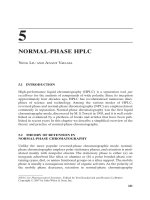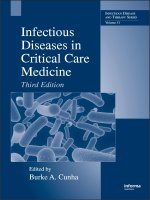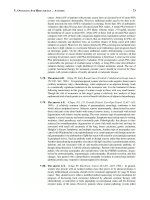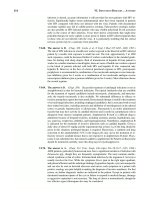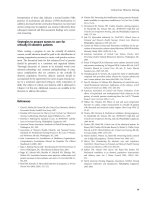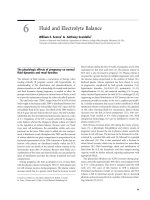Critical care medicine - part 5 pdf
Bạn đang xem bản rút gọn của tài liệu. Xem và tải ngay bản đầy đủ của tài liệu tại đây (90.87 KB, 15 trang )
Asthma 63
testinal disturbances and increased serum aminotransferase activity.
Drug-induced lupus and Churg-Strauss vasculitis have been reported.
4. Zileuton (Zyflo) is modestly effective for maintenance treatment, but
it is taken four times a day and patients must be monitored for hepatic
toxicity.
D. Cromolyn (Intal) and nedocromil (Tilade)
1. Cromolyn sodium, an inhibitor of mast cell degranulation, can
decrease airway hyperresponsiveness in some patients with asthma.
The drug has no bronchodilating activity and is useful only for
prophylaxis. Cromolyn has virtually no systemic toxicity.
2. Nedocromil has similar effects as cromolyn. Both cromolyn and
nedocromil are much less effective than inhaled corticosteroids.
E. Theophylline
1. Oral theophylline has a slower onset of action than inhaled beta
2
agonists and has limited usefulness for treatment of acute symptoms.
It can, however, reduce the frequency and severity of symptoms,
especially in nocturnal asthma, and can decrease inhaled
corticosteroid requirements.
2. When theophylline is used alone, serum concentrations between 8-12
mcg/mL provide a modest improvement is FEV
1
. Serum levels of 15-
20 mcg/mL are only minimally more effective and are associated with
a higher incidence of cardiovascular adverse events.
F. Oral corticosteroids are the most effective drugs available for acute
exacerbations of asthma unresponsive to bronchodilators.
1. Oral corticosteroids decrease symptoms and may prevent an early
relapse. Chronic use of oral corticosteroids can cause glucose
intolerance, weight gain, increased blood pressure, osteoporosis,
cataracts, immunosuppression and decreased growth in children.
Alternate-day use of corticosteroids can decrease the incidence of
adverse effects, but not of osteoporosis.
2. Prednisone, prednisolone or methylprednisolone (Solu-Medrol),
40-60 mg qd; for children, 1-2 mg/kg/day to a maximum of 60 mg/day.
Therapy is continued for 3-10 days. The oral steroid dosage does not
need to be tapered after short-course “burst” therapy if the patient is
receiving inhaled steroid therapy.
G. Choice of drugs
1. Patients with infrequent mild symptoms of asthma may require only
intermittent use, as needed, of a short-acting inhaled beta
2
-adrenergic
agonist. Overuse of inhaled short-acting beta
2
agonists or more than
twice a week indicates that an inhaled corticosteroid should be added
to the treatment regimen.
Pharmacotherapy for Asthma Based on Disease Classification
Classification Long-term control medications Quick-relief medications
Mild intermit-
tent
Short-acting beta
2
agonist as
needed
Mild persistent Low-dose inhaled corticosteroid
or cromolyn sodium (Intal) or
nedocromil (Tilade)
Short-acting beta
2
agonist as
needed
64 Chronic Obstructive Pulmonary Disease
Classification Long-term control medications Quick-relief medications
Moderate per-
sistent
Medium-dose inhaled cortico-
steroid plus a long-acting
bronchodilator (long-acting beta
2
agonist)
Short-acting beta
2
agonist as
needed
Severe persis-
tent
High-dose inhaled corticosteroid
plus a long-acting bronchodilator
and systemic corticosteroid
Short-acting beta
2
agonist as
needed
III. Management of acute exacerbations
A. High-dose, short-acting beta
2
agonists delivered by a metered-dose
inhaler with a volume spacer or via a nebulizer remains the mainstay of
urgent treatment.
B. Most patients require therapy with systemic corticosteroids to resolve
symptoms and prevent relapse.
C. Hospitalization should be considered if the PEFR remains less than 70%
of predicted. Patients with a PEFR less than 50% of predicted who exhibit
an increasing pCO
2
level and declining mental status are candidates for
intubation.
D. Non-invasive ventilation with bilevel positive airway pressure (BIPAP) may
be used to relieve the work-of-breathing while awaiting the effects of acute
treatment, provided that consciousness and the ability to protect the
airway have not been compromised.
Chronic Obstructive Pulmonary Disease
Chronic obstructive pulmonary disease affects more than 20 million Americans.
This condition is composed of three distinct entities: 1) chronic bronchitis; 2)
emphysema; and 3) peripheral airway disease. The greatest percentage of
patients with COPD have chronic bronchitis.
I. Clinical evaluation
A. The majority of patients with COPD will have either a history of cigarette
smoking or exposure to second-hand cigarette smoke. Occasionally,
patients will develop COPD from occupational exposure. A minority of
patients develop emphysema as a result of alpha-1-protease inhibitor
deficiency or intravenous drug abuse.
B. The patient with acute exacerbations of COPD (AECOPD) usually will
complain of cough, sputum production, and/or dyspnea. Acute exacerba-
tions may be precipitated by an infectious process, exposure to noxious
stimuli, or environmental changes. It is important to compare the current
illness with the severity of previous episodes and to determine if the
patient has had previous intubations or admissions to the ICU.
C. Intercostal retractions, accessory muscle use, and an increase in pulsus
paradoxus usually suggest significant airway obstruction.
D. Wheezing is usually present. Emphysema is manifested by an elongated,
hyperresonant chest. Diaphragmatic flatteningand increased radiolucency
is seen on the chest x-ray.
Chronic Obstructive Pulmonary Disease 65
II. Infectious precipitants of acute exacerbations of COPD
A. About 32% of patients with an acute exacerbation have a viral infection.
The most common agents are influenza virus, parainfluenzae, and
respiratory syncytial virus.
B. Bacterial precipitants play an important etiologic role in AECOPD. H.
influenzae is the most common pathogen, occurring in 19%, followed by
Streptococcus pneumoniae in 12% and Moraxella catarrhalis in 8%.
Patients with COPD have chronic colonization of the respiratory tree with
Streptococcus pneumoniae, Haemophilus influenzae, and Haemophilus
parainfluenzae.
III. Diagnostic testing
A. Pulse oximetry is an inexpensive, noninvasive procedure for assessing
oxygen saturation.
B. Arterial blood gases. Both hypercarbia and hypoxemia occur when
pulmonary function falls to below 25-30% of the predicted normal value.
C. Pulmonary function testing is a useful means for assessing ventilatory
function. Peak-flow meters are available that can provide a quick
assessment of expiratory function.
D. Chest radiography will permit identification of patients with COPD with
pneumonia, pneumothorax, and decompensated CHF.
E. An ECG may be useful in patients who have a history of chest pain,
syncope, and palpitations.
F. Labs: Complete blood count (CBC) is useful in patients with acute
exacerbation of COPD if pneumonia is suspected. The hematocrit is
frequently elevated as a result of chronic hypoxemia. A serum
theophylline level should be obtained in patients who are taking
theophylline. Each milligram per kilogram of theophylline raises the serum
theophylline level by about 2 mcg/mL.
IV. Pharmacotherapy for patient stabilization
A. Oxygen. Patients in respiratory distress should receive supplemental
oxygen therapy. Oxygen therapy usually is initiated by nasal cannula to
maintain an O
2
saturation greater than 90%. Patients with hypercarbia
may require controlled oxygen therapy using a Venturi mask in order to
achieve more precise control of the FiO
2
.
B. Beta-agonists are first-line therapy for AECOPD. Albuterol is the most
widely used agent.
Beta-Agonist Dosages
Agent MDI Aerosol
Albuterol
(Proventil, Ventolin)
2-4 puffs q4h 0.5 cc (2.5 mg)
Pirbuterol (Maxair) 2 puffs q4-6h
Salmeterol (Serevent) 2 puffs q12h
C. Anticholinergic agents produce preferential dilatation of the larger
central airways, in contrast to beta-agonists, which affect the peripheral
airways. Ipratropium is a first-line therapeutic option for chronic, outpatient
66 Chronic Obstructive Pulmonary Disease
management of stable patients with COPD. The usual dose is 2-4 puffs
every six hours. The inhalation dose is 500 mcg/2.5 mL solution nebulized
3-4 times daily.
D. Corticosteroids. Rapidly tapering courses of corticosteroids are effective
in preventing relapses and maintaining longer symptom-free intervals in
patients who have had AECOPD. Patients with an acute exacerbation of
COPD should receive steroids as a mainstay of outpatient therapy. There
is no role for inhaled corticosteroids in the treatment of acute exacerba-
tions.
1. Oral steroids are warranted in severe COPD. Prednisone 0.5-1.0
mg/kg or 40 mg qAM. The dose should be tapered over 1-2 weeks
following clinical improvement.
2. Aerosolized corticosteroids provide the benefits of oral corticosteroids
with fewer side effects.
Triamcinolone (Azmacort) MDI 2-4 puffs bid.
Flunisolide (AeroBid, AeroBid-M) MDI 2-4 puffs bid.
Beclomethasone (Beclovent) MDI 2-4 puffs bid.
Budesonide (Pulmicort) MDI 2 puffs bid.
3. Side effects of corticosteroids. Cataracts, osteoporosis, sodium and
water retention, hypokalemia, muscle weakness, aseptic necrosis of
femoral and humeral heads, peptic ulcer disease, pancreatitis,
endocrine and skin abnormalities, muscle wasting.
E. Theophylline has a relatively narrow therapeutic index with side effects
that range from nausea, vomiting, and tremor to more serious side effects,
including seizures and ventricular arrhythmias. Dosage of long-acting
theophylline (Slo-bid, Theo-Dur) is 200-300 mg bid. Theophylline
preparations with 24-hour action may be administered once a day in the
early evening. Theo-24, 100-400 mg qd [100, 200, 300, 400 mg].
F. Salmeterol (Serevent) is a long-acting beta-agonist, which may improve
nocturnal dyspnea and reduce the frequency of beta-agonist rescue use.
2 puffs q12h.
G. Summary of therapeutic approaches
1. Acute exacerbations are treated with systemic steroids, antibiotics,
and inhaled beta-agonists with combined ipratropium. Lack of
improvement should prompt addition of theophylline, salmeterol, non-
invasive ventilatory support (BIPAP), or intubation with mechanical
ventilatory support.
2. Chronic and stable COPD is treated with scheduled doses of
ipratropium in combination with albuterol. Salmeterol and theophylline
are added when symptom control is difficult. Addition of an inhaled
steroid may be beneficial in selected patients. Continuous oxygen
therapy has clear benefits when indicated by a resting, exercise, or
sleeping PaO
2
<55 mm Hg.
H. Antibiotics. Amoxicillin-resistant, beta-lactamase-producing H. influenzae
are common. Azithromycin has an appropriate spectrum of coverage.
Levofloxacin is advantageous when gram-negative bacteria or atypical
organisms predominate. Amoxicillin-clavulanate has in vitro activity
against beta-lactamase-producing H. influenzae and M. catarrhalis.
Pleural Effusion 67
Recommended Dosing and Duration of Antibiotic Therapy for Acute
Exacerbations of COPD
Mild-to-moderate acute exacerbations of COPD
• Azithromycin (Zithromax): 500 mg on 1st day, 250 mg qd × 4 days or
clarithromycin (Biaxin) 500 mg PO bid.
• Amoxicillin/clavulanate (Augmentin): 500 mg tid × 10 days or
875 mg bid × 10 days.
Severe acute exacerbations of COPD
• Levofloxacin (Levaquin): 500 mg qd × 7-14 days
Alternative agents for treatment of uncomplicated, acute exacerba-
tions of chronic bronchitis
• Trimethoprim/sulfamethoxazole (Bactrim, Septra): 1 DS tab PO bid 7-
14 days
• Amoxicillin (Amoxil, Wymox): 500 mg tid × 7-14 days
• Doxycycline (Vibramycin): 100 mg bid × 7-14 days
V. Ventilatory assistance
A. Patients with extreme dyspnea, discordant breathing, fatigue, inability to
speak, or deteriorating mental status in the face of adequate therapy may
require ventilatory assistance. Hypoxemia that does not respond to
oxygen therapy or worsening of acid-base status in spite of controlled
oxygen therapy may also require ventilatory assistance.
B. Noninvasive, nasal, or bilevel positive airway pressure (BiPAP) may
improve respiratory rate, tidal volume, and minute ventilation. Patients
successfully treated with noninvasive ventilation have a lower incidence
of pneumonia and sinusitis.
VI. Surgical treatment. Lung volume reduction surgery (LVRS) consists of
surgical removal of an emphysematous bulla. This procedure can ameliorate
symptoms and improve pulmonary function. Lung transplantation is reserved
for those patients deemed unsuitable or too ill for LVRS.
VII. Hypoxemia adversely affects function and increases risk the of death, and
oxygen therapy is the only treatment documented to improve survival in
patients with COPD. Oxygen is usually delivered by nasal cannula at a flow
rate sufficient to maintain an optimal oxygen saturation level.
Pleural Effusion
Pre-thoracentesis chest x-ray: A bilateral decubitus x-ray should be obtained
before the thoracentesis. Thoracentesis is safe when fluid freely layers out
and is greater than 10 mm in depth on the decubitus film.
Labs: CBC, ABG, SMA 12, protein, albumin, amylase, rheumatoid factor, ANA,
ESR. INR/PTT, UA. Chest x-ray PA & LAT repeat after thoracentesis,
bilateral decubitus, ECG.
Pleural fluid analysis:
Tube 1. LDH, protein, amylase, triglyceride, glucose (10 mL).
68 Pleural Effusion
Tube 2. Gram stain, C&S, AFB, fungal C&S, (20-60 mL, heparinized).
Tube 3. Cell count and differential (5-10 mL, EDTA).
Tube 4. Antigen tests for S. pneumoniae, H. influenza (25-50 mL,
heparinized).
Syringe. pH (2 mL collected anaerobically, heparinized on ice)
Bottle. Cytology.
Differential Diagnosis
Pleural Fluid Param-
eters
Transudate Exudate
LDH (IU) <200 >200
Pleural LDH/serum
LDH
<0.6 >0.6
Total protein (g/dL) <3.0 >3.0
Pleural Protein/serum
Protein
<0.5 >0.5
Differential Diagnosis of Transudates: Congestive heart failure, cirrhosis.
Differential Diagnosis of Exudates: Empyema, viral pleuritis, tuberculosis,
neoplasm, uremia, drug reaction, asbestosis, sarcoidosis, collagen disease
(lupus, rheumatoid disease), pancreatitis, subphrenic abscess.
Chylous Effusions: Triglyceride >110
Malignant Effusions: Cytology positive in 60% of effusions.
Treatment: Chest tube drainage is indicated for complicated parapneumonic
effusions (pH <7.10, glucose <40 mEq/dL, LDH >1000 IU/L) and frank
empyema. Rapid removal may rarely cause re-expansion pulmonary edema.
References
Ferretti GR, et al. Acute pulmonary embolism; Role of helical CT in 164 patients with
intermediate probability at ventilation-perfusion scintigraphy and normal results at duplex
US of the legs. Radiology 1997, 205: 453-458.
Kollef et al. The Acute Respiratory Distress syndrome. NEJM 1995,332(1):27-37
Amato et al. Effect of a protective-ventilation strategy on mortality in the ARDS. NEJM
1998,338(6)347-54
McIntyre NR. Clinically available new strategies for mechanical ventilatory support. Chest,
1993, 104(2):500-5.
Tobin MJ. Mechanical Ventilation. NEJM, 1994, 330(15): 1056-61
Esteban A et al. A Comparison of four methods of weaning patients from mechanical
ventilation. NEJM, 1995, 332 (6):345-350.
The Columbus Investigators. Low-Molecular Weight Heparin in the Treatment of patients
with venous thromboembolism. NEJM 1997, 337(10):657-662.
Pneumothorax 69
Trauma
Blanding U. Jones, MD
Pneumothorax
I. Management of pneumothorax
A. Small primary spontaneous pneumothorax (<10-15%): (not associ-
ated with underlying pulmonary diseases). If the patient is not
dyspneic.
1. Observe for 4-8 hours and repeat a chest x-ray.
2. If the pneumothorax does not increase in size and the patient remains
asymptomatic, consider discharge home with instructions to rest and
curtail all strenuous activities. The patient should return if there is an
increase in dyspnea or recurrence of chest pain.
B. Secondary spontaneous pneumothorax (associated with underlying
pulmonary pathology, emphysema) or primary spontaneous
pneumothorax >15%, or if patient is symptomatic.
1. Give high-flow oxygen by nasal cannula. A needle thoracotomy should
be placed at the anterior, second intercostal space in the midclavicular
line.
2. Anesthetize and prep the area, then insert a 16-gauge needle with an
internal catheter and a 60 mL syringe, attached via a 3-way stopcock.
Aspirate until no more air is aspirated. If no additional air can be
aspirated, and the volume of aspirated air is <4 liters, occlude the
catheter and observe for 4 hours.
3. If symptoms abate and chest-x-ray does not show recurrence of the
pneumothorax, the catheter can be removed, and the patient can be
discharged home with instructions.
4. If the aspirated air is >4 liters and additional air is aspirated without
resistance, this represents an active bronchopleural fistula with
continued air leak. Admission is required for insertion of a chest tube.
C. Traumatic pneumothorax associated with a penetrating injury,
hemothorax, mechanical ventilation, tension pneumothorax, or if
pneumothorax does not resolve after needle aspiration: Give high-
flow oxygen and insert a chest tube. Do not delay the management of a
tension pneumothorax until radiographic confirmation; insert needle
thoracotomy or chest tube immediately.
D. Iatrogenic pneumothorax
1. Iatrogenic pneumothoraces include lung puncture caused by
thoracentesis or central line placement.
2. Administer oxygen by nasal cannula.
3. If the pneumothorax is less than 10% and the patient is asymp-
tomatic, observe and repeat chest x-ray in 4 hours. If unchanged,
manage expectantly with close follow-up, and repeat chest x-ray in 24
hours.
4. If the pneumothorax is more than 10% and/or the patient is
symptomatic, perform a tube thoracostomy under negative pressure.
70 Tension Pneumothorax
II. Technique of chest tube insertion
A. Place patient in supine position, with involved side elevated 20 degrees.
Abduct the arm to 90 degrees. The usual site is the fourth or fifth
intercostal space, between the mid-axillary and anterior axillary line
(drainage of air or free fluid). The point at which the anterior axillary fold
meets the chest wall is a useful guide. Alternatively, the second or third
intercostal space, in the midclavicular line, may be used for pneumothorax
drainage alone (air only).
B. Cleanse the skin with Betadine iodine solution, and drape the field.
Determine the intrathoracic tube distance (lateral chest wall to the apices),
and mark the length of tube with a clamp.
C. Infiltrate 1% lidocaine into the skin, subcutaneous tissues, intercostal
muscles, periosteum, and pleura using a 25-gauge needle. Use a scalpel
to make a transverse skin incision, 2 centimeters wide, located over the
rib, just inferior to the interspace where the tube will penetrate the chest
wall.
D. Use a Kelly clamp to bluntly dissect a subcutaneous tunnel from the skin
incision, extending just over the superior margin of the lower rib. Avoid the
nerve, artery and vein located at the upper margin of the intercostal
space.
E. Penetrate the pleura with the clamp, and open the pleura 1 centimeter.
With a gloved finger, explore the subcutaneous tunnel, and palpate the
lung medially. Exclude possible abdominal penetration, and ensure
correct location within pleural space; use finger to remove any local
pleural adhesions.
F. Use the Kelly clamp to grasp the tip of the thoracostomy tube (36 F,
internal diameter 12 mm), and direct it into the pleural space in a
posterior, superior direction for pneumothorax evacuation. Direct the tube
inferiorly for pleural fluid removal. Guide the tube into the pleural space
until the last hole is inside the pleural space and not inside the subcutane-
ous tissue.
G. Attach the tube to a underwater seal apparatus containing sterile normal
saline, and adjust to 20 cm H
2
O of negative pressure, or attach to suction
if leak is severe. Suture the tube to the skin of the chest wall using O silk.
Apply Vaseline gauze, 4 x 4 gauze sponges, and elastic tape. Obtain a
chest x-ray to verify correct placement and evaluate reexpansion of the
lung.
Tension Pneumothorax
I. Clinical evaluation
A. Clinical signs: Severe hemodynamic and/or respiratory compromise;
contralaterally deviated trachea; decreased or absent breath sounds and
hyperresonance to percussion on the affected side; jugular venous
distention, asymmetrical chest wall motion with respiration.
B. Radiologic signs: Flattening or inversion of the ipsilateral
hemidiaphragm; contralateral shifting of the mediastinum; flattening of the
cardio-mediastinal contour and spreading of the ribs on the ipsilateral
side.
Cardiac Tamponade 71
II. Acute management
A. A temporary large-bore IV catheter may be inserted into the ipsilateral
pleural space, at the level of the second intercostal space at the
midclavicular line until the chest tube is placed.
B. A chest tube should be placed emergently.
C. Draw blood for CBC, INR, PTT, type and cross-matching, chem 7,
toxicology screen.
D. Send pleural fluid for hematocrit, amylase and pH (to rule out esophageal
rupture).
E. Indications for cardiothoracic exploration: Severe or persistent
hemodynamic instability despite aggressive fluid resuscitation, persistent
active blood loss from chest tube, more than 200 cc/hr for 3 consecutive
hours, or
$1½ L of acute blood loss after chest tube placement.
Cardiac Tamponade
I. General considerations
A. Cardiac tamponade occurs most commonly secondary to penetrating
injuries.
B. Beck's Triad: Venous pressure elevation, drop in the arterial pressure,
muffled heart sounds. Other signs include enlarged cardiac silhouette on
chest x-ray; signs and symptoms of hypovolemic shock; pulseless
electrical activity, decreased voltage on ECG.
C. Kussmaul's sign is characterized by a rise in venous pressure with
inspiration. Pulsus paradoxus or elevated venous pressure may be
absent when associated with hypovolemia.
II. Management
A. Pericardiocentesis is indicated if the patient is unresponsive to resuscita-
tion measures for hypovolemic shock, or if there is a high likelihood of
injury to the myocardium or one of the great vessels.
B. All patients who have a positive pericardiocentesis (recovery of non-
clotting blood) because of trauma, require an open thoracotomy with
inspection of the myocardium and the great vessels.
C. Rule out other causes of cardiac tamponade such as pericarditis,
penetration of central line through the vena cava, atrium, or ventricle, or
infection.
D. Consider other causes of hemodynamic instability that may mimic cardiac
tamponade (tension pneumothorax, massive pulmonary embolism, shock
secondary to massive hemothorax).
Pericardiocentesis
I. General considerations
A. If acute cardiac tamponade with hemodynamic instability is suspected,
emergency pericardiocentesis should be performed; infusion of Ringer's
lactate, crystalloid, colloid and/or blood may provide temporizing mea-
sures.
72 Pericardiocentesis
II. Management
A. Protect airway and administer oxygen. If patient can be stabilized,
pericardiocentesis should be performed in the operating room or catheter
lab. The para-xiphoid approach is used for pericardiocentesis.
B. Place patient in supine position with chest elevated at 30-45 degrees,
then cleanse and drape peri-xiphoid area. Infiltrate lidocaine 1% with
epinephrine (if time permits) into skin and deep tissues.
C. Attach a long, large bore (12-18 cm, 16-18 gauge), short bevel cardiac
needle to a 50 cc syringe with a 3-way stop cock. Use an alligator clip to
attach a V-lead of the ECG to the metal of the needle.
D. Advance the needle just below costal margin, immediately to the left and
inferior to the xiphoid process. Apply suction to the syringe while advanc-
ing the needle slowly at a 45 -degree horizontal angle towards the mid
point of the left clavicle.
E. As the needle penetrates the pericardium, resistance will be felt, and a
“popping” sensation will be noted.
F. Monitor the ECG for ST segment elevation (indicating ventricular heart
muscle contact); or PR segment elevation (indicating atrial epicardial
contact). After the needle comes in contact with the epicardium, withdraw
the needle slightly. Ectopic ventricular beats are associated with cardiac
penetration.
G. Aspirate as much blood as possible. Blood from the pericardial space
usually will not clot. Blood, inadvertently, drawn from inside the ventricles
or atrium usually will clot. If fluid is not obtained, redirect the needle more
towards the head. Stabilize the needle by attaching a hemostat or Kelly
clamp.
H. Consider emergency thoracotomy to determine the cause of
hemopericardium (especially if active bleeding). If the patient does not
improve, consider other problems that mayresemble tamponade, such as
tension pneumothorax, pulmonary embolism, or shock secondary to
massive hemothorax.
References
Committee on Trauma, American College of Surgeons: Early Care of the Injured Patient.
Philadelphia, WB Sanders Co., 1982, pp 142-148.
Light RW. Management of Spontaneous Pneumothorax. Am. Rev. Res. Dis. 1993; 148, 1:
245-248.
Light RW. Pneumothorax. In: Light RW, ed. Pleural Diseases. Philadelphia; Lea &
Farbiger, 1990; 237-62.
Transfusion Reactions 73
Hematologic Disorders
Thomas Vovan, MD
Transfusion Reactions
I. Acute hemolytic transfusion reaction
A. Transfusion reactions are rare and most commonly associated with ABO
incompatibility, usually related to a clerical error. Early symptoms include
sudden onset of anxiety, flushing, tachycardia, and hypotension. Chest
and back pain, fever, and dyspnea are common.
B. Life-threatening manifestations include vascular collapse (shock), renal
failure, bronchospasm, and disseminated intravascular coagulation.
C. Hemoglobinuria, and hemoglobinemia occurs because of intravascular
red cell lysis.
D. The direct antiglobulin test (direct Coombs test) is positive. The severity
of reaction is usually related to the volume of RBCs infused.
E. Management
1. The transfusion should be discontinued immediately, and the unused
donor blood and a sample of recipient’s venous blood should be sent
for retyping and repeat cross match, including a direct and indirect
Coombs test.
2. Urine analysis should be checked for free hemoglobin and centrifuged
plasma for pink coloration (indicating free hemoglobin).
3. Hypotension should be treated with normal saline. Vasopressors may
be used if volume replacement alone is inadequate to maintain blood
pressure.
4. Maintain adequate renal perfusion with volume replacement.
Furosemide may be used to maintain urine output after adequate
volume replacement has been achieved.
5. Monitor INR/PTT, platelets, fibrinogen, and fibrin degradation products
for evidence of disseminated intravascular coagulation. Replace
required clotting factors with fresh frozen plasma, platelets, and/or
cryoprecipitate.
II. Febrile transfusion reaction (nonhemolytic)
A. Febrile transfusion reactions occur in 0.5-3% of transfusions. It is most
commonly seen in patients receivingmultiple transfusions. Chills develop,
followed by fever, usually during or within a few hours of transfusion. This
reaction may be severe but is usually mild and self limited.
B. Management
1. Symptomatic and supportive care should be provided with
acetaminophen and diphenhydramine. Meperidine 50 mg IV is useful
in treating chills. A WBC filter should be used for the any subsequent
transfusions.
2. More serious transfusion reactions must be excluded (eg, acute
hemolytic reaction or bacterial contamination of donor blood).
III. Transfusion-related noncardiogenic pulmonary edema
A. This reaction is characterized by sudden development of severe
respiratory distress, associated with fever, chills, chest pain, and
hypotension.
74 Disseminated Intravascular Coagulation
B. Chest radiograph demonstrates diffuse pulmonary edema. This reaction
may be severe and life threatening but generally resolves within 48 hours.
C. Management
1. Treatment of pulmonary edema and hypoxemia may include mechani-
cal ventilatory support and hemodynamic monitoring.
2. Diuretics are useful only if fluid overload is present. Use a WBC filter
should be used for any subsequent transfusions.
Disseminated Intravascular Coagulation
I. Clinical manifestations
A. Disseminated intravascular coagulation (DIC) is manifest by generalized
ecchymosis and petechiae, bleeding from peripheral IV sites, central
catheters, surgical wounds, and oozing from gums.
B. Gastrointestinal and urinary tract bleeding are frequently encountered.
Grayish discoloration or cyanosis of the distal fingers, toes, or ears may
occur because of intravascular thrombosis. Large, sharply demarcated,
ecchymotic areas may be seen as a result of thrombosis.
II. Diagnosis
A. Fibrin degradation products are the most sensitive screening test for DIC;
however, no single laboratory parameter is diagnostic of DIC.
B. Peripheral smear: Evidence of microangiopathic hemolysis, with
schistocytes and thrombocytopenia, is often present. A persistently normal
platelet count nearly excludes the diagnosis of acute DIC.
C. Coagulation studies: INR, PTT, and thrombin time are generally
prolonged. Fibrinogen levels are usually depleted (<150 mg/dL). Fibrin
degradation products (>10 mg/dL) and D-dimer is elevated (>0.5 mg/dL).
III. Management of disseminated intravascular coagulation
A. The primary underlying precipitating condition (eg, sepsis) should be
treated. Severe DIC with hypocoagulability may be treated with replace-
ment of clotting factors. Hypercoagulability is managed with heparin.
B. Severe hemorrhage and shock is managed with fluids and red blood cell
transfusions.
C. If the patient is at high risk of bleeding or actively bleeding with DIC:
Replace fibrinogen with 10 units of cryoprecipitate. Replace clotting factors
with 2-4 units of fresh frozen plasma. Replace platelets with platelet
pheresis.
D. If factor replacement therapy is transfused, fibrinogen and platelet
levels should be obtained 30-60 minutes post-transfusion and every 4-6
hours thereafter to determine the efficacy of therapy. Each unit of platelets
should increase the platelet count by 5000-10,000/mcL. Each unit of
cryoprecipitate should increase the fibrinogen level by 5-10 mg/dL.
E. Heparin
1. Indications for heparin include evidence of fibrin deposition (ie, dermal
necrosis, acral ischemia, venous thromboembolism). Heparin is used
when the coagulopathy is believed to be secondary to a retained, dead
fetus, amniotic fluid embolus, giant hemangioma, aortic aneurysm, solid
tumors, or promyelocytic leukemia. Heparin is also used when clotting
factors cannot be corrected with replacement therapy alone.
2. Heparin therapy is initiated at a relatively low dose (5-10 U/kg/hr) by
continuous IV infusion without a bolus. Coagulation parameters must
Thrombolytic-associated Bleeding 75
then be followed to guide therapy. The heparin dose may be increased
by 2.5 U/kg/hr until the desired effect is achieved.
Thrombolytic-associated Bleeding
I. Clinical presentation: Post-fibrinolysis hemorrhage may present as a sudden
neurologic deficit (intracranial bleeding), massive GI bleeding, progressive
back pain accompanied by hypotension (retroperitoneal bleeding), or a
gradual decline in hemoglobin without overt evidence of bleeding.
II. Laboratory evaluation
A. Low fibrinogen (<100 mg/dL) and elevated fibrin degradation products
confirm the presence of a lytic state. Elevated thrombin time and PTT may
suggest a persistent lytic state; however, both are prolonged in the
presence of heparin. Prolonged reptilase time identifies the persistent lytic
state in the presence of heparin.
B. Depleted fibrinogen in the fibrinolytic state will be reflected by an elevated
PTT, thrombin time, or reptilase time. The post-transfusion fibrinogen level
is a useful indicator of response to replacement therapy.
C. The bleeding time may be a helpful guide to platelet replacement therapy
if the patient has persistent bleeding despite factor replacement with
cryoprecipitate and fresh frozen plasma.
III. Management
A. Discontinue thrombolytics, aspirin, and heparin immediately, and consider
protamine reversal of heparin and cryoprecipitate to replenish fibrinogen.
B. Place two large-bore IV catheters for volume replacement. If possible,
apply local pressure to bleeding sites. Blood specimens should be sent for
INR/PTT, fibrinogen, and thrombin time. Reptilase time should be checked
if the patient is also receiving heparin. Patient's blood should be typed and
crossed because urgent transfusion may be needed.
C. Transfusion
1. Cryoprecipitate (10 units over 10 minutes) should be transfused to
correct the lytic state. Transfusions may be repeated until the fibrinogen
level is above 100 mg/dL or hemostasis is achieved. Cryoprecipitate is
rich in fibrinogen and factor VIII.
2. Fresh frozen plasma transfusion is also important for replacement of
factor VIII and V. If bleeding persists after cryoprecipitate and FFP
replacement, check a bleeding time and consider platelet transfusion
if bleeding time is greater than 9 minutes. If bleeding time is less than
9 minutes, then antifibrinolytic drugs may be warranted.
D. Antifibrinolytic agents
1. Aminocaproic acid (EACA) inhibits the conversion of plasminogen to
plasmin. It is used when replacement of blood products are not
sufficient to attain hemostasis.
2. Loading dose: 5 g or 0.1 g/kg IV infused in 250 cc NS over 30-60 min,
followed by continuous infusion at 0.5-2.0 g/h until bleeding is con-
trolled. Use with caution in upper urinary tract bleeding because of the
potential for obstruction.
References
Carr JM, McKinney M, McDonagh J: Diagnosis of Disseminated Intravascular Coagulation,
Role of D-Dimer. Am J Clin Pathol 1989;91:280-287.
76 Thrombolytic-associated Bleeding
Feinstein DI: Treatment of Disseminated Intravascular Coagulation. Seminars in Thrombosis
and Hemostasis. 1988;14:351-362.
Sane DC, Califf RM, Topol EJ, Stump DC, Mark DB, Greenberg CS: Bleeding during
Thrombolytic Therapy for Acute Myocardial Infarction: Mechanisms and Management.
Ann of Int Med. 1989;111:1010-1022.
Bacterial Meningitis 77
Infectious Diseases
Guy Foster, MD
Farhad Mazdisnian, MD
Michael Krutzik, MD
Georgina Heal, MD
Bacterial Meningitis
The age group at greatest risk for acute bacterial meningitis (ABM) includes
children between 1 and 24 months of age. Adultsolder than 60 years old account
for 50% of all deaths related to meningitis.
I. Clinical presentation
A. Eighty-five percent of patients with bacterial meningitis present with fever,
headache, meningismus or nuchal rigidity, and altered mental status.
Other common signs and symptoms include photophobia, vomiting, back
pain, myalgias, diaphoresis, and malaise. Generalized seizures can occur
in up to 40% of patients with ABM.
B. Kernig's sign (resistance to extension of the leg while the hip is flexed) and
Brudzinski's sign (involuntaryflexion of the hip and knee when the patient's
neck is abruptly flexed while laying supine) are observed in up to 50% of
patients.
C. About 50% of patients with N. meningitidis may present with an
erythematous macular rash, which progresses to petechiae and purpura.
II. Patient evaluation
A. Computerized tomography (CT). Patients who require CT prior to LP
include those with focal neurologic findings, papilledema, focal seizures,
or abnormalities on exam that suggest increased intracranial pressure. If
bacterial meningitis is a strong consideration, and the decision is made to
perform a CT prior to LP, two sets of blood cultures should be obtained
and antibiotics should be administered before sending the patient for
neuroimaging. Urine cultures may be helpful in the very young and very
old.
B. Blood cultures followed by antibiotic administration within 30 minutes of
presentation is mandatory in all patients suspected of having bacterial
meningitis.
C. Interpretation of lumbar puncture. Examination of the CSF is mandatory
for evaluation of meningitis.
D. CSF, Gram’s stain, and culture are positive in 70-85% of patients with
ABM.
